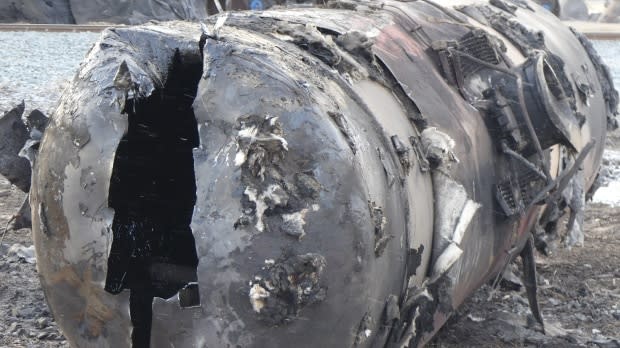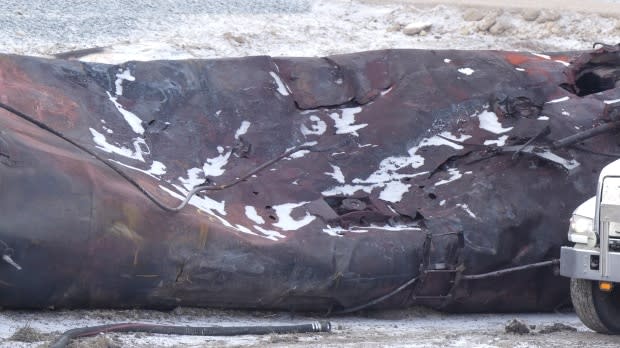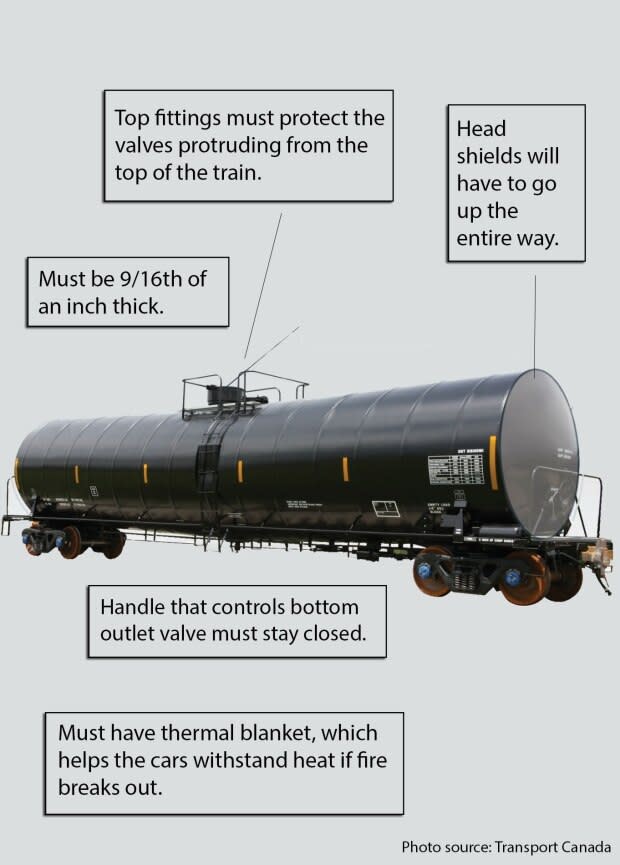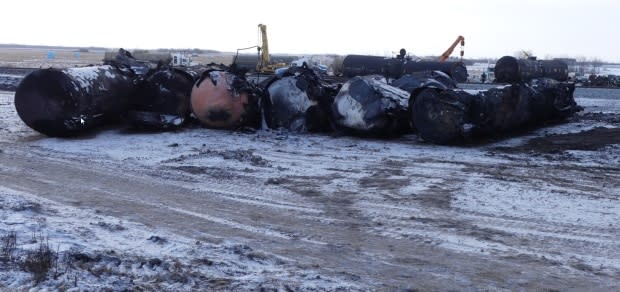U.S. rail carrier reportedly cracked down on same retrofitted tank type involved in fiery Sask. derailment
Transport Canada says "only the most crash-resistant tank cars available" are allowed to haul crude oil on Canadian rail lines.
But the Canadian Pacific Railway train that derailed on a remote patch of Saskatchewan farmland Monday, leaking an estimated 1.5 million litres of oil and igniting a large blaze, was pulling retrofitted steel tank cars that are not the thickest available.
The same retrofitted tank type has reportedly been cracked down upon by a major rail carrier of crude oil in the United States, following a June 2018 derailment in Iowa that leaked 870,645 litres of oil into a waterway.
CP has confirmed that the train that derailed west of Guernsey, Sask., this week was hauling a mix of jacketed CPC-1232 cars and TC-117R cars.

TC-117R cars are retrofitted to meet the same standards as brand new TC-117s, which are meant to be less prone to rupturing during crashes.
"The features [for new and retrofitted 117 cars] are the same and include thermal protection, top fitting protection, new bottom outlet valves, full head shield protection and a jacket," a spokesperson for Transport Canada said earlier this week.
'Not quite brand new'
But Ian Naish, a former director of rail investigations for the Transportation Safety Board of Canada, said the shells on retrofitted 117R cars are slightly thinner than those on new 117 cars: 7/16th of an inch thick, versus 9/16th of an inch thick.
"They are almost equivalent," Naish said. "[They] are not quite brand new but better than what was there before."
Naish was referring to the TC-111 cars that were involved in the July 2013 Lac-Mégantic, Que., rail disaster that killed 47 people.
In the wake of the crash, Transport Canada called for the TC-117 rail cars to become the new standard for transporting flammable liquids.

The agency also ordered that CPC-1232 tank cars that do not feature jackets for thermal protection be phased out by November 2018.
19 tanks lost entire loads of oil
The Transportation Safety Board of Canada is investigating Monday's CP derailment. According to an update provided by the TSB Wednesday, 33 cars went off the tracks. Nine of them were the retrofitted 117R type, while the remaining 24 were jacketed CPC-1232 cars.
The TSB said about 20 of the tanks ruptured and released oil, with 19 of the cars losing their entire loads.
The TSB did not specify which tank type suffered the worst damage but engineers will be examining all damaged tanks closely.
"We'd have to see what happened to the actual cars that ruptured or released product," Naish, the former TSB investigator, said. "But if the tank car shells were an issue, obviously the 7/16ths-of-inch shells aren't very good. And maybe the 9/16ths would have been better."

CP has previously said it does not own the rail cars involved in Monday's derailment but has declined to say who does.
U.S. rail carrier banned 117R cars
Retrofitted TC-117R rail car tanks were on the train hauling Canadian oil that derailed in Iowa in June 2018, according to Reuters. The railway involved, the BNSF Railway Company, then moved to ban the use of 117R cars on its lines.
"BNSF continues to handle all car types allowed under federal regulation for crude but we are working with our individual customers to facilitate getting the newest and safest tank cars in service sooner on our railroad," BNSF spokesperson Amy Casas told CBC.
"That refers to the transition to the [new] 117s," she added for clarification.
No one was injured in Monday's Saskatchewan derailment, nor was it the largest release of oil in the province's history, according to the Saskatchewan government.
But it's unclear if it represents the largest release of oil carried by rail in the province.

The estimated amount released onto the farmland near Guernsey, 1.5 million litres, is more than six times the amount that spilled into the North Saskatchewan River in 2016 after a Husky Energy pipeline leaked near Maidstone, Sask.
The TSB has said Monday's leak did not affect any waterways but said its definition of waterways does not include the water table.
Melanie Loessl, whose pasture land is located right near the derailment site, said she is worried about any potential impacts to her drinking water.
Emily Eaton, an associate professor at the University of Regina's department of geography and environmental studies, said spills on land, as opposed to water, are easier to contain.


